Abstract
The increase in energy consumption may accelerate studies focusing on increasing the efficiency of current energy sources and utilization of renewable energy sources.
For transportation, renewable energy sources are getting more important because of strictly regulated emission values and vehicle noise restrictions in urban areas for quality of life requirements.
Researches in electrical transformation, energy storage, weight reduction and aerodynamic improvements are getting popular with increasing number of electric vehicles. In this study, the aerodynamic effects of composite (Polymer Composites Plate) wheel cover of the EV Demobil 09 produced by Solaris Team of Dokuz Eylül University is analyzed.
Composite wheel covers were produced by vacuum assisted resin transfer molding (VARTM) methods. To improve the aerodynamic characteristics, the flow around the vehicle were examined via CFD (Computational Fluid Dynamics) methods.
1. Introduction
In this study, composite wheel covers were produced and their effect on the aerodynamic structure of EV Demobil 09 were investigated.
In first part of the study a composite wheel cover is produced with vacuum assisted resin transfer molding (VARTM). In the second step, the aerodynamic results of EV wheels fitted with these covers are examined.
2. Materials and Methods
2.1. Polymer Composite Structure

Figure 1. Vacuum assisted resin transfer molding (VARTM) method [9]
Polymeric composites contain polymeric matrix and fibers in their structure. Thus, these structures have very high specific strengths. These composites are used on vehicles widely. Different number of composite layers, fiber angles, fiber structure and density result in different mechanical properties.
In VARTM method, the resin building the composite matrix flows in a vacuumed environment. There are many advantages of VARTM compared to other manufacturing methods. These advantages are listed below. [2]
• Resin/Fiber ratio in VARTM is reverse with regards to hand lay-up method. Higher strength and more durable parts are obtained with lower resin amount in VARTM,
• Unstable material usage is prevented, and a more uniform material is obtained with VARTM,
• Production area is clear from pollutants and there is less gas build-up during production.
The production of composite wheel cover to be produced by vacuum assisted resin transfer molding (VARTM) method of EV Demobil 09 started with preparing cavity side of the molds. (See Figure 2)
In the second step, first composite fibers are prepared. Composite fiber arrangement is shown in Figure 1. [9]
Then the liquid release agent and a release film is applied to mold. Thus, the product can be removed from the mold easily. After that a carbon fiber fabric is placed and a peel fly is laid out to remove the product easily after vacuum.
The vacuum bag is fixed by sealant tape. Technical properties of carbon fiber and epoxy resin are as detailed in Table 1 and 2.

Figure 2. Designed molds for composite wheel cover of EV Demobil 09

Table 1. Technical Properties of Dowaksa 200 [gr/m2] 3K- Plain
Carbon Fiber

Table 2. Technical Properties of Epoxy Resin

Figure 3. Vacuum infusion
processing
Previous studies [2,9] show that vacuum assisted resin transfer molding (VARTM) method gives a uniform, lightweight and durable product while using a lower amount of resin in the composite structure. The properties of composite wheel cover which is produced by VARTM is detailed in Table 3.

Table 3. The properties of composite wheel cover
 Talha Batuhan Korkut
Dokuz Eylül University
Department of Mechanical Engineering
Automated Control and Robotics Laboratories
Talha Batuhan Korkut
Dokuz Eylül University
Department of Mechanical Engineering
Automated Control and Robotics Laboratories
 Dr. Aytaç Gören
Dokuz Eylül University
Department of Mechanical Engineering
Automated Control and Robotics Laboratories
Dr. Aytaç Gören
Dokuz Eylül University
Department of Mechanical Engineering
Automated Control and Robotics Laboratories
 Onur Özaydın
R&D Engineer
Cevher Jant Sanayii A.Ş.
Onur Özaydın
R&D Engineer
Cevher Jant Sanayii A.Ş.
 Elvan Armakan
R&D Engineer
Cevher Jant Sanayii A.Ş.
Elvan Armakan
R&D Engineer
Cevher Jant Sanayii A.Ş.







 Talha Batuhan Korkut
Dokuz Eylül University
Department of Mechanical Engineering
Automated Control and Robotics Laboratories
Talha Batuhan Korkut
Dokuz Eylül University
Department of Mechanical Engineering
Automated Control and Robotics Laboratories
 Dr. Aytaç Gören
Dokuz Eylül University
Department of Mechanical Engineering
Automated Control and Robotics Laboratories
Dr. Aytaç Gören
Dokuz Eylül University
Department of Mechanical Engineering
Automated Control and Robotics Laboratories
 Onur Özaydın
R&D Engineer
Cevher Jant Sanayii A.Ş.
Onur Özaydın
R&D Engineer
Cevher Jant Sanayii A.Ş.
 Elvan Armakan
R&D Engineer
Cevher Jant Sanayii A.Ş.
Elvan Armakan
R&D Engineer
Cevher Jant Sanayii A.Ş.